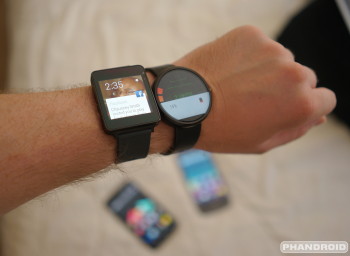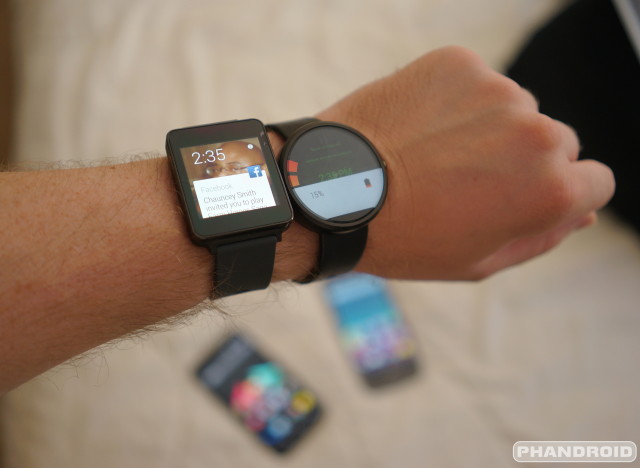
Battery life test: Moto 360 vs LG G Watch
Although beauty is often said to lay in the eye of the beholder, there’s no denying the raw sex appeal of the Motorola Moto 360. Motorola did a great job at making their first Android Wear entry as svelte as possible. In fact, according to your own votes, many of you find the 360 the best looking smartwatch to date, even when compared against upcoming wearables like the Apple Watch or ASUS ZenWatch.
When the Moto 360 launched late last week, many of you were ready to throw your money at the screen as soon as stock became available. But early reports of less than stellar battery life may have tarnished the smartwatch’s desirability for some of you (our own Joe Fedewa can attest to this). Thanks to an all around smaller 320mAh battery, we didn’t expect the Moto 360 to last quite as long as rival offerings from LG or Samsung, both of which feature larger 400mAh batteries. We knew this going in. But because of the 360’s unique ambient light sensor which allows the watch to automatically control the brightness of the display according to its surroundings, we were willing to give the 360 the benefit of the doubt.
Of course, we wanted to settle this once and for all and after putting the device through our own 2-day battery life test, we’re now ready to share those results with all of you. For some, the results may be surprising and for others, some relief.
How we performed our tests
Before we start let’s cover a little background information on exactly how we performed our test. For the first day, we connected our Moto 360 to our Moto X (2nd Gen), while the LG G Watch was connected to our HTC One M8. Both handsets are running the same apps and since both have active cellular service, push the same amount of notifications to their connected watches. Both devices were running the same 4.4W firmware on day 1, then updated to 4.4W.1 on day 2.
Since this was more or less an endurance test, we didn’t perform any voice searches or interact with the watches much more than viewing notifications and checking the time every so often. Since both watches were attached to the same arm, both would activate their displays simultaneously when viewing the time or peeking at notifications To keep everything fair, on the second day, we simply swapped the connected devices and started over. This, we hope, helped keep things fair and the margin of error to a minimum.
Here’s what we found:
Results
As you can see, concerns with the Moto 360 not lasting a full day are, for the most part (at least in our test) completely unwarranted. The watch has consistently taken us through an entire work day (8 hours), with more than a little juice left over when we laid our heads to sleep at night (17 hours). Since there was plenty of juice left in both devices, both tests saw each watch left unplugged overnight. Although essentially in standby mode with no movement, they continued to receive notifications throughout the night.
We will note that despite their low power state, the Moto 360 saw the same discharge rate as during the day, a full 20% decrease over 9 hours. The LG G Watch? Barely 11%. Upon seeing this, we have strong suspicions the dramatic difference in battery life between the two devices has more to do with the processors employed in each than actual battery capacity.
As a refresher, the LG G Watch uses a newer Qualcomm Snapdragon 400 processor manufactured using a low power 28nm process. We’re not sure exactly why, but for whatever reason Motorola sought fit to go with a single-core TI OMAP 3 processor — similar to the one used in 2010’s Motorola Droid X — using a far more power hungry 45 nm process.
So, what of those reports of “10-hour battery life?” We will note that although ambient display mode — which keeps the display always powered on and dimly lit — taxes the battery on both devices, the Moto 360 saw an incredibly huge dip to about 10 hours of battery life when active (the G Watch, not nearly as much). It’s a good thing Motorola keeps ambient display mode turned off out of the box — different from the LG G Watch or Samsung Gear Live where ambient mode is on by default — and if you have a Moto 360, you’re going to want to keep it off. Always.
Conclusion
Nobody wants to have to charge yet another device every night, but with a solid average of 20+ hours of battery life, you shouldn’t be all too concerned with charging the device at any point during waking hours (only while you sleep). In the event you should forget to charge your watch before bed, the good news is that because of the teensy, tiny little batteries in these smartwatches, charging the Moto 360 is super quick. It’s possible to have a fully charged watch in less than an hour and you can do that during your morning rituals.
All-in-all, we’d still consider the Moto 360 the absolute bare minimum of smartwatch battery life. Keep in mind that as Android Wear progresses and more features are rolled into the OS, there’s a pretty good chance battery life could be further impacted by future updates. Google already said music streaming over Bluetooth was coming in the near future, along with custom watch faces and more. But in its current state, the Moto 360 will do you just fine and looks great too.

